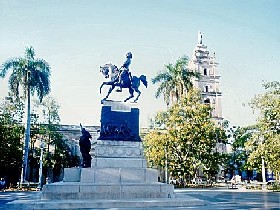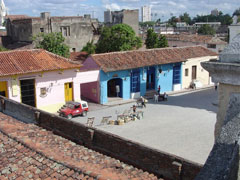|
CAMAGÜEY
 Originally named as Santa María del Puerto del Príncipe it was one of the first seven villas founded by the Spanish and its name apparently comes from the aborigine chief Camaguebax.
The city, also known for its large earthenware jars (tinajones), rises up between the rivers of Tínima and Hatibonico. It boasts ancient dwellings and mansions over two centuries old.
The city also features religious constructions, among them the Cathedral, the churches of Carmen and Santa Ana, all forming part of the historical quarters that are declared a Heritage of Humanity.
Originally named as Santa María del Puerto del Príncipe it was one of the first seven villas founded by the Spanish and its name apparently comes from the aborigine chief Camaguebax.
The city, also known for its large earthenware jars (tinajones), rises up between the rivers of Tínima and Hatibonico. It boasts ancient dwellings and mansions over two centuries old.
The city also features religious constructions, among them the Cathedral, the churches of Carmen and Santa Ana, all forming part of the historical quarters that are declared a Heritage of Humanity.
For more information:
www.cuba-cayosabinal.com
,
www.cuba-santalucia.com
,
www.cuba-camaguey.com
|
|
|
JIMAGUAYÚ
The war was reinforced in the eastern provinces of Oriente, Camagüey and Las Villas, during the days of September 13 to 16th of 1895, due to the fact that a meeting was held in Jimaguayú, a historical site of the restructuring by Agramonte. The representatives of the Cuban revolutionaries in arms gathered in order to establish the laws by which the young Revolution would continue its path to victory.
It was General Máximo Gómez who chose the spot, it was where in 1873 Major General Ignacio Agramonte fell in brutal combat for freedom.
Here, the illustrious Dominican placed his troops in order to protect those that were to reflect on the Carta Magna, a document that would succeed the Guáimaro Constitution of 1869.
Everything was ready so that the chosen patriots were able to constitute the Revolutionary Parliament in Jimaguayú, whose sessions were held in a humble “bohio” made of palm leaves, under the presidency of Salvador Cisneros Betancourt.
The Constitution of Jimaguayú established, like its predecessor of Guaímaro in 1869, a centralised government of the Republic, but unlike its predecessor, it joined the legislative and executive powers in one legal body.
This reduced the size of the power structure which allowed faster decisions to be made on issues of the State, a result of the experiences of the Ten Year War (Guerra de los 10 Años).
For more information:
www.cuba-heroes.com
,
www.cuba-history.com
,
www.cuba-camaguey.com
,
www.aboutcuba.com
|
|
|
NUEVITAS
It was officially founded as a city in 1818, although its history dates back to November 18th of 149, when Christopher Columbus landed on its shores and in a beautiful place lacking trees he raised a great cross, naming it Puerto Príncipe (Prince’s Port), as well as naming a group of isles the King’s Gardens (Jardines del Rey) and the bay or gulf that bathed its shores, Our Lady’s Sea (Mar de Nuestra Señora).
The area covers a surface of 2,948 square kilometres and features a beautiful bay as well as a notable industrial development, with the production of cement as the main product in the sustained economic rates.
Due to its history as well as the beautiful landscapes that attract visitors, together with the striking combination of marine azure and intensely green vegetation, Nuevitas deserves to be included among the tourist destinies in the province of Camagüey.
For more information:
www.cuba-cayosabinal.com
,
www.cuba-santalucia.com
,
www.cuba-camaguey.com
|
|
|
SABANA-CAMAGÜEY ARCHIPELAGO
 This is the largest archipelago of those that surround the island of Cuba and is part of the province of Ciego de Ávila. The most famous, the Gardens of the King (Jardines del Rey) is of astounding beauty and is one of the main tourist destinies of beaches in the country.
Its marine bottoms are protected by a coral reef that is the second most extensive in the world, because the first is in Australia.
Among the Jardines del Rey, the most well known destinies are Cayo Coco, from where the coconut bird, also known as white ibis can be seen, and Cayo Guillermo, with the pleasant presence of pink flamencos. It is an isle of 13 square kilometres and features one of the highest dunes in the world, reaching up to 15 meters height.
The archipelago is connected by land to the larger island of Cuba and an airport with a capacity of receiving medium size and small planes is also located here.
This is the largest archipelago of those that surround the island of Cuba and is part of the province of Ciego de Ávila. The most famous, the Gardens of the King (Jardines del Rey) is of astounding beauty and is one of the main tourist destinies of beaches in the country.
Its marine bottoms are protected by a coral reef that is the second most extensive in the world, because the first is in Australia.
Among the Jardines del Rey, the most well known destinies are Cayo Coco, from where the coconut bird, also known as white ibis can be seen, and Cayo Guillermo, with the pleasant presence of pink flamencos. It is an isle of 13 square kilometres and features one of the highest dunes in the world, reaching up to 15 meters height.
The archipelago is connected by land to the larger island of Cuba and an airport with a capacity of receiving medium size and small planes is also located here.
For more information:
www.cuba-cayococo.com
,
www.cuba-cayoguillermo.com
,
www.cuba-cayolevisa.com
,
www.cuba-ciegodeavila.com
,
www.cuba-jardinesdelrey.com
|
|
|
San Juan de Dios Square
 The existence of this unequalled spot in the city of Camagüey dates back to the XVIII century (1728), according to documents from the ancient villa of Santa María of Puerto del Príncipe. The name of the architectural ensemble comes from the order of the Brothers of Saint John of God (Hermanos de San Juan de Dios).
The majestic colonial architecture has been preserved in the legendary city and is still a part of the stoned plaza, next to the old hospital, a church and some houses, two of which have been turned into restaurants. The place can be reached through the well-known Worker’s Plaza (Plaza de los Trabajadores) after winding through a tangle of streets. Once there, the visitors are awed by the unique beauty of sculptures, paintings and other projects that mingle harmoniously in an area hailed as a National Monument.
The existence of this unequalled spot in the city of Camagüey dates back to the XVIII century (1728), according to documents from the ancient villa of Santa María of Puerto del Príncipe. The name of the architectural ensemble comes from the order of the Brothers of Saint John of God (Hermanos de San Juan de Dios).
The majestic colonial architecture has been preserved in the legendary city and is still a part of the stoned plaza, next to the old hospital, a church and some houses, two of which have been turned into restaurants. The place can be reached through the well-known Worker’s Plaza (Plaza de los Trabajadores) after winding through a tangle of streets. Once there, the visitors are awed by the unique beauty of sculptures, paintings and other projects that mingle harmoniously in an area hailed as a National Monument.
For more information:
www.cuba-history.com
,
www.cuba-camaguey.com
|
|
|
THE PLACE WHERE THE GUAIMARO ASSEMBLY (ASAMBLEA DE GUÁIMARO) WAS HELD
As an adequate precursor for such great history, the first Constitution of the Republic in Arms was held at Guáimaro, a territory located east of Camagüey, where the main protagonists of the insurrection met in April of 1869, only a few months after the beginning of the first struggle for the nation’s freedom.
In this encounter, in which the bravest representatives of independence took part, the necessary unity within the revolution prevailed against the different ideas that had been maintained up to the moment in the field of insurrection.
The opinions of Carlos Manuel de Céspedes on one united leadership, where the civilian and military roles were controlled by the same person, were opposed to the opinions of those from Camaguey, who thought it was prudent to separate both roles, with an internal division of the civilian command.
Imagine for an instant those men of strict personality, most of them educated in the best colleges of the country and in foreign parts as well, decided on risking their lives and wealth in the struggle, firm and convinced of their own ideas.
They defended their ideas with ardour and bravery, and we can visualise the intense panorama of the Guaimaro Assembly sessions (Asamblea de Guáimaro).
Finally, the firm and coherent block made up of those from Camaguey and Villa Clara prevailed, in which the young lawyer Ignacio Agramonte y Loynaz played quite a part, and from whose pen the project of the Constitution was born.
For more information:
www.cuba-heroes.com
,
www.cuba-history.com
,
www.cuba-camaguey.com
,
www.aboutcuba.com
|
|